Evaluation of Acceptance Capacity of Distributed Generation in Distribution Network Considering Carbon Emission
Abstract
:1. Introduction
- (1)
- The carbon emission is innovatively quantified as one of the sub-objectives of the acceptance capacity evaluation model of DG. The proposed model aims to minimize the carbon emission in the full life cycle, minimize the node voltage deviation and maximize the line capacity margin, which comprehensively considers the reliable, economic and low-carbon operation requirements of the distribution network with high penetration renewable energy access.
- (2)
- An improved NSGA-II is used to solve the proposed multi-objective optimization model. By selecting the compromise optimal solution from the Pareto optimal solution set, the compromise optimal solution, including the location and capacity decisions of the candidate DG, obtained better performance.
2. Multi-Objective Evaluation Model of Acceptance Capacity of DG in Distribution Network Considering Carbon Emission
2.1. Objective Function
2.1.1. Minimizing Carbon Emission in the Full Life Cycle
2.1.2. Minimizing Node Voltage Deviation
2.1.3. Maximizing Line Capacity Margin
2.2. Constraints
2.2.1. Power Flow Constraints
2.2.2. Node Voltage Constraints
2.2.3. Line Transmission Capacity Constraints
2.2.4. DG Output Constraints
2.2.5. Load Loss Constraints
3. Solving Process of Acceptance Capacity Evaluation of DG in Distribution Network Based on Improved NSGA-II
3.1. Phase I: The Acquirement of the Pareto Frontier Solution Set with NSGA-II for Acceptance Capacity Evaluation of DG
- Input the distribution network topology information and parameters and set k = 1;
- Initialize the parent population of DG access scheme;
- Calculate the carbon emission in the full life cycle, the node voltage deviation and the line capacity margin of each parent population;
- Use NSGA-II to sort the parent population;
- Use the tournament method to screen the parent population;
- Cross and mutate the screened parent population to obtain the offspring population;
- Calculate the carbon emissions of the full life cycle (f1), the node voltage deviation (f2) and the line capacity margin (f3) of the k-th generation population of DG access scheme;
- Merge the parent and offspring populations of the k-th generation DG access scheme;
- Use the improved NSGA-II and congestion calculation to sort the merged k-th generation DG access scheme;
- Screen the merged k-th generation DG access scheme with the elite strategy to obtain the k+1-th generation population and set k = k + 1;
- Update the Pareto optimal solution set according to the dominant relationship between the corresponding objective function values of each particle in the population;
- If k reaches the maximum number of iterations, output the Pareto optimal solution set of the acceptance capacity evaluation of DG; otherwise, turn to Step 6.
3.2. Phase II: The Determination of the Optimal Compromise Solution with the Entropy Weight Method for the Acceptance Capacity Evaluation of DG
3.3. Model Solving Process
4. Case Study
5. Conclusions
Author Contributions
Funding
Institutional Review Board Statement
Informed Consent Statement
Data Availability Statement
Conflicts of Interest
References
- Rafiee, A.; Karimi, M.; Safari, A.; Abbasi Talabari, F. The Future Impact of Carbon Tax on Electricity Flow between Great Britain and Its Neighbors until 2030. Appl. Sci. 2021, 11, 10460. [Google Scholar] [CrossRef]
- Remarks by Chinese President Xi Jinping at Leaders Summit on Climate. Available online: http://www.china.org.cn/world/2021-04/23/content_77432607.htm (accessed on 30 March 2022).
- Ghiasi, M.; Niknam, T.; Dehghani, M.; Siano, P.; Haes Alhelou, H.; Al-Hinai, A. Optimal Multi-Operation Energy Management in Smart Microgrids in the Presence of RESs Based on Multi-Objective Improved DE Algorithm: Cost-Emission Based Optimization. Appl. Sci. 2021, 11, 3661. [Google Scholar] [CrossRef]
- Liu, S.; You, S.; Lin, Z.; Zeng, C.; Li, H.; Wang, W.; Hu, X.; Liu, Y. Data-driven Event Identification in the US Power Systems Based on 2D-OLPP and RUSBoosted Trees. IEEE Trans. Power Syst. 2022, 1, 94–105. [Google Scholar] [CrossRef]
- Wang, H.; Shen, X.; Liu, J. Planning of New Distribution Network Considering Green Power Certificate Trading and Carbon Emissions Trading. Energies 2022, 15, 2435. [Google Scholar] [CrossRef]
- Tian, G.; Yu, S.; Wu, Z.; Xia, Q. Study on the Emission Reduction Effect and Spatial Difference of Carbon Emission Trading Policy in China. Energies 2022, 15, 1921. [Google Scholar] [CrossRef]
- Zhou, Q.; Shahidehpour, M.; Sun, T.; Feng, D.; Yan, M. Cooperative Game for Carbon Obligation Allocation Among Distribution System Operators to Incentivize the Proliferation of Renewable Energy. IEEE Trans. Smart Grid 2019, 10, 6355–6365. [Google Scholar] [CrossRef]
- Pourakbari-Kasmaei, M.; Lehtonen, M.; Contreras, J.; Mantovani, J.R.S. Carbon Footprint Management: A Pathway toward Smart Emission Abatement. IEEE Trans. Ind. Inform. 2020, 16, 935–948. [Google Scholar] [CrossRef] [Green Version]
- Han, X.; Qiu, J.; Sun, L.; Shen, W.; Ma, Y.; Yuan, D. Low-Carbon Energy Policy Analysis Based on Power Energy System Modeling. Energy Convers. Econ. 2020, 1, 34–44. [Google Scholar] [CrossRef]
- Kang, C.; Zhou, T.; Chen, Q.; Wang, J.; Sun, Y.; Xia, Q.; Yan, H. Carbon Emission Flow from Generation to Demand: A Network-Based Model. IEEE Trans. Smart Grid 2015, 6, 2386–2394. [Google Scholar] [CrossRef]
- Ren, S.; Wang, J.; Gong, X.; Gong, L.; Peng, X.; Ao, J. Low-Carbon Economic Dispatching for Integrated Energy System Based on Coordinated Optimization of Power to Gas and Carbon Capture Power Plant. In Proceedings of the 2019 IEEE 3rd Conference on Energy Internet and Energy System Integration (EI2), Changsha, China, 8–10 November 2019. [Google Scholar]
- Fan, V.H.; Meng, K.; Qiu, J.; Dong, Z. Stochastic Distribution Expansion Planning with Wind Power Generation and Electric Vehicles Considering Carbon Emissions. In Proceedings of the 2020 4th International Conference on Green Energy and Applications (ICGEA), Singapore, 7–9 March 2020. [Google Scholar]
- Guo, L.; Liu, W.; Jiao, B.; Hong, B.; Wang, C. Multi-Objective Stochastic Optimal Planning Method for Stand-Alone Microgrid System. IET Gener. Transm. Distrib. 2014, 8, 1263–1273. [Google Scholar] [CrossRef]
- Zhang, T.; Luo, F.; Hu, S.; Yang, X. Evaluation Model and Method on Life-Cycle Comprehensive Low-Carbon Benefits of Large-Scale Energy Storage System from the Distribution Network Planning Perspective. In Proceedings of the 2020 IEEE 4th Conference on Energy Internet and Energy System Integration (EI2), Wuhan, China, 30 October–1 November 2020. [Google Scholar]
- Yue, G.; Hongbin, Z.; Kai, C. Life-Cycle Low Carbon Simulation of Smart Distribution Network Considering Power Loss. In Proceedings of the 2018 2nd IEEE Conference on Energy Internet and Energy System Integration (EI2), Beijing, China, 20–22 October 2018. [Google Scholar]
- Xu, Y.; Liu, Z.; Wen, F.; Palu, I. Receding-Horizon Based Optimal Dispatch of Virtual Power Plant Considering Stochastic Dynamic of Photovoltaic Generation. Energy Convers. Econ. 2021, 2, 45–53. [Google Scholar] [CrossRef]
- Li, Z.; Su, S.; Zhao, Y.; Jin, X.; Chen, H.; Li, Y.; Zhang, R. Energy Management Strategy of Active Distribution Network with Integrated Distributed Wind Power and Smart Buildings. IET Renew. Power Gener. 2020, 14, 2255–2267. [Google Scholar] [CrossRef]
- The State Council Information Office Held a Press Conference on China’s Renewable Energy Development. Available online: http://www.nea.gov.cn/2021-03/30/c_139846095.htm (accessed on 30 March 2022).
- Wang, X.; Gao, C.; Wu, W.; Chang, X.; Gao, S. Stochastic DG Capacity Assessment for Active Distribution Networks Considering the Optimal Reactive DG Outputs and OLTC Operation. In Proceedings of the 2017 IEEE Conference on Energy Internet and Energy System Integration (EI2), Beijing, China, 26–28 November 2017. [Google Scholar]
- Lu, Q.; Lin, Z.; Liu, S.; Zhu, Y.; Yang, Y.; Cai, Q. DG Capacity Assessment in Distribution Network Considering Uncertainties Using Multi-Parametric Programming. In Proceedings of the 2018 2nd IEEE Conference on Energy Internet and Energy System Integration (EI2), Beijing, China, 20–22 October 2018. [Google Scholar]
- Solat, S.; Aminifar, F.; Shayanfar, H. Distributed Generation Hosting Capacity in Electric Distribution Network in the Presence of Correlated Uncertainties. IET Gener. Transm. Distrib. 2021, 15, 836–848. [Google Scholar] [CrossRef]
- Wang, S.; Chen, S.; Ge, L.; Wu, L. Distributed Generation Hosting Capacity Evaluation for Distribution Systems Considering the Robust Optimal Operation of OLTC and SVC. IEEE Trans. Sustain. Energy 2016, 7, 1111–1123. [Google Scholar] [CrossRef]
- Fan, S.; Li, C.; Wei, Z.; Pu, T.; Liu, X. Method to Determine the Maximum Generation Capacity of Distribution Generation in Low-Voltage Distribution Feeders. J. Eng. 2017, 2017, 944–948. [Google Scholar] [CrossRef]
- Chen, X.; Wu, W.; Zhang, B. Robust Capacity Assessment of Distributed Generation in Unbalanced Distribution Networks Incorporating ANM Techniques. IEEE Trans. Sustain. Energy 2018, 9, 651–663. [Google Scholar] [CrossRef] [Green Version]
- Ali, A.; Keerio, M.U.; Laghari, J.A. Optimal Site and Size of Distributed Generation Allocation in Radial Distribution Network Using Multi-Objective Optimization. J. Mod. Power Syst. Clean Energy 2021, 9, 404–415. [Google Scholar] [CrossRef]
- Selim, A.; Kamel, S.; Alghamdi, A.S.; Jurado, F. Optimal Placement of DGs in Distribution System Using an Improved Harris Hawks Optimizer Based on Single- and Multi-Objective Approaches. IEEE Access 2020, 8, 52815–52829. [Google Scholar] [CrossRef]
- Hou, H.; Liu, P.; Xiao, Z.; Deng, X.; Huang, L.; Zhang, R.; Xie, C. Capacity Configuration Optimization of Standalone Multi-Energy Hub Considering Electricity, Heat and Hydrogen Uncertainty. Energy Convers. Econ. 2021, 2, 122–132. [Google Scholar] [CrossRef]
- Li, W.; Wang, Q. Stochastic Production Simulation for Generating Capacity Reliability Evaluation in Power Systems with High Renewable Penetration. Energy Convers. Econ. 2020, 1, 210–220. [Google Scholar] [CrossRef]
- Huang, Y.; Lin, Z.; Liu, X.; Yang, L.; Dan, Y.; Zhu, Y.; Ding, Y.; Wang, Q. Bi-Level Coordinated Planning of Active Distribution Network Considering Demand Response Resources and Severely Restricted Scenarios. J. Mod. Power Syst. Clean Energy 2021, 9, 1088–1100. [Google Scholar] [CrossRef]
- Bilgundi, S.K.; Sachin, R.; Pradeepa, H.; Nagesh, H.B.; Likith Kumar, M.V. Grid Power Quality Enhancement Using an ANFIS Optimized PI Controller for DG. Prot. Control Mod. Power Syst. 2022, 7, 3. [Google Scholar] [CrossRef]
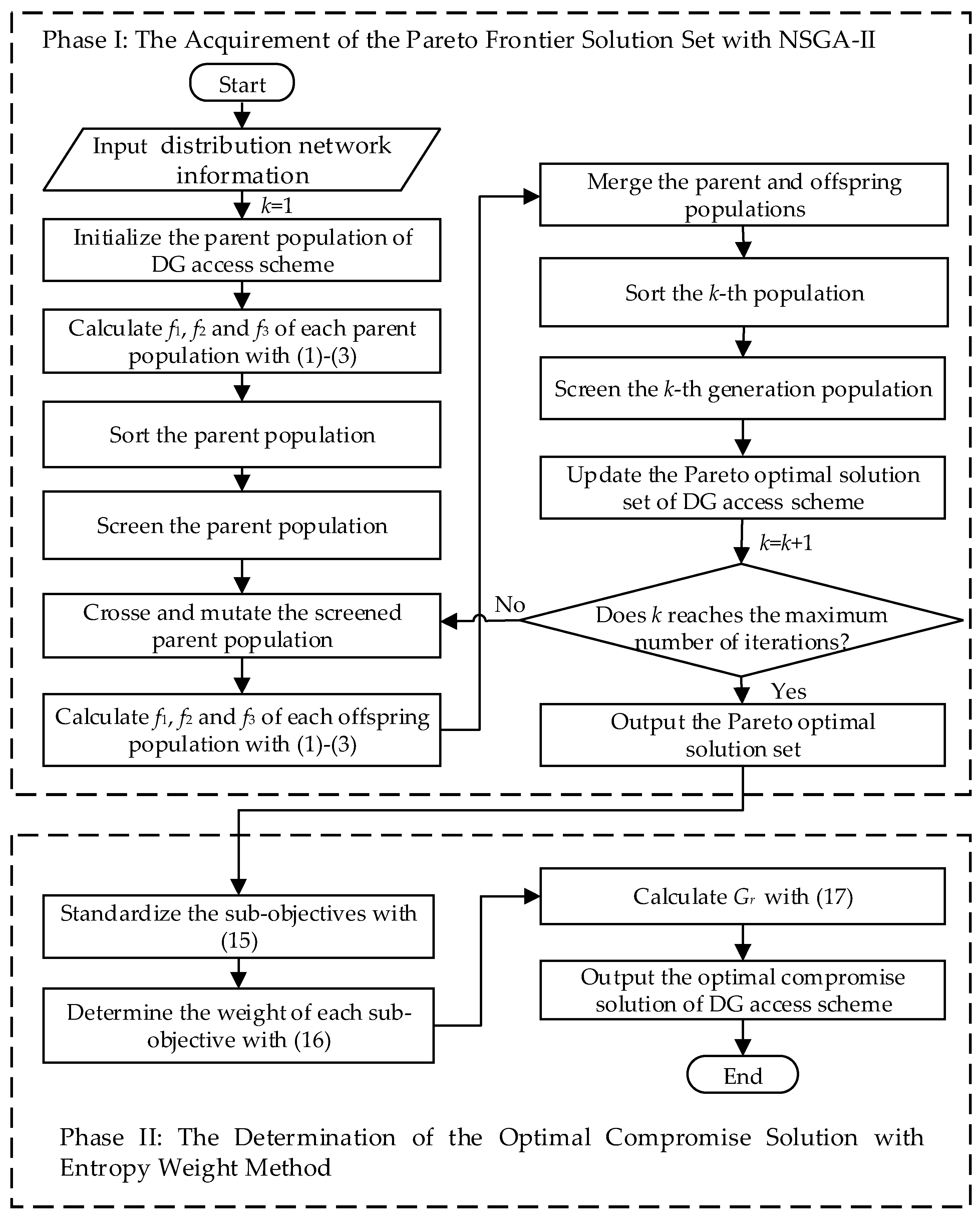
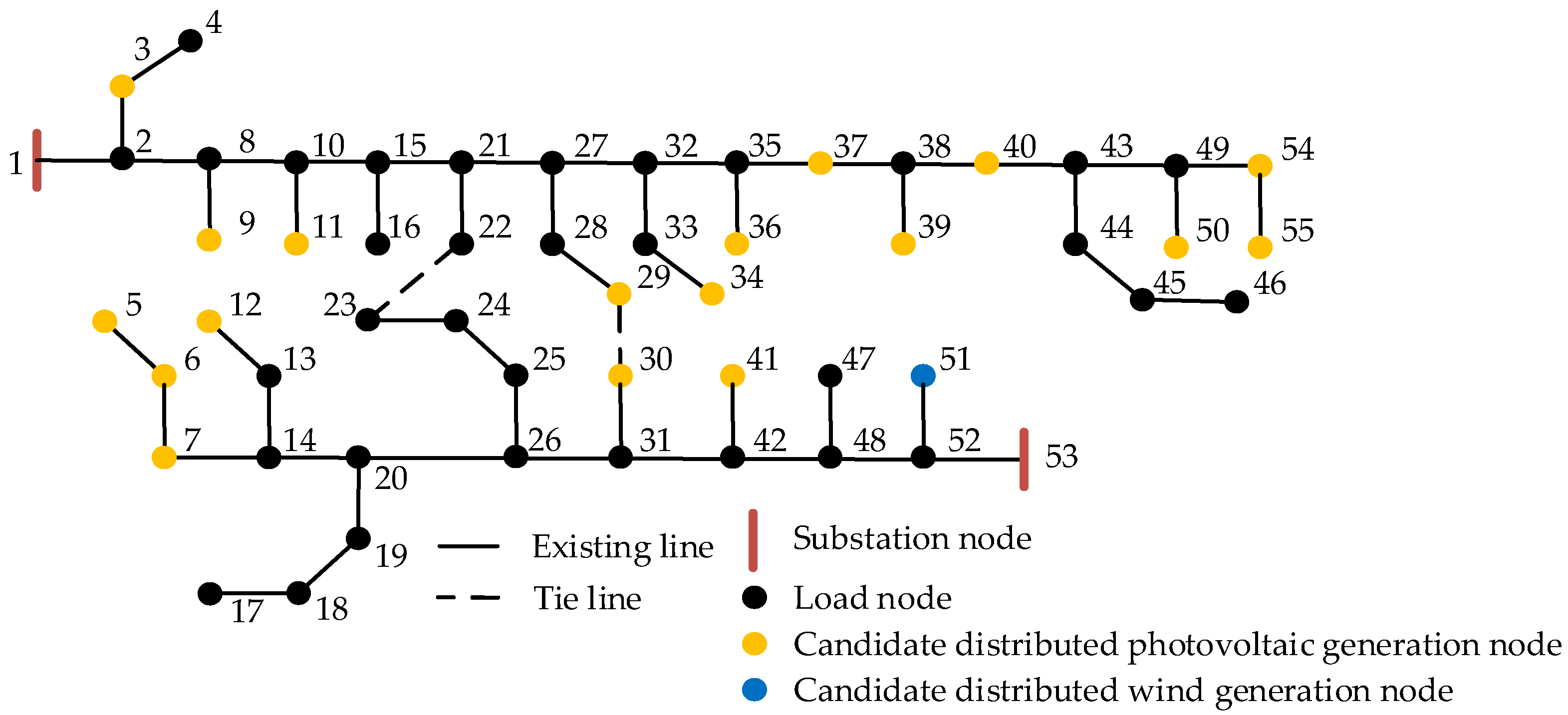
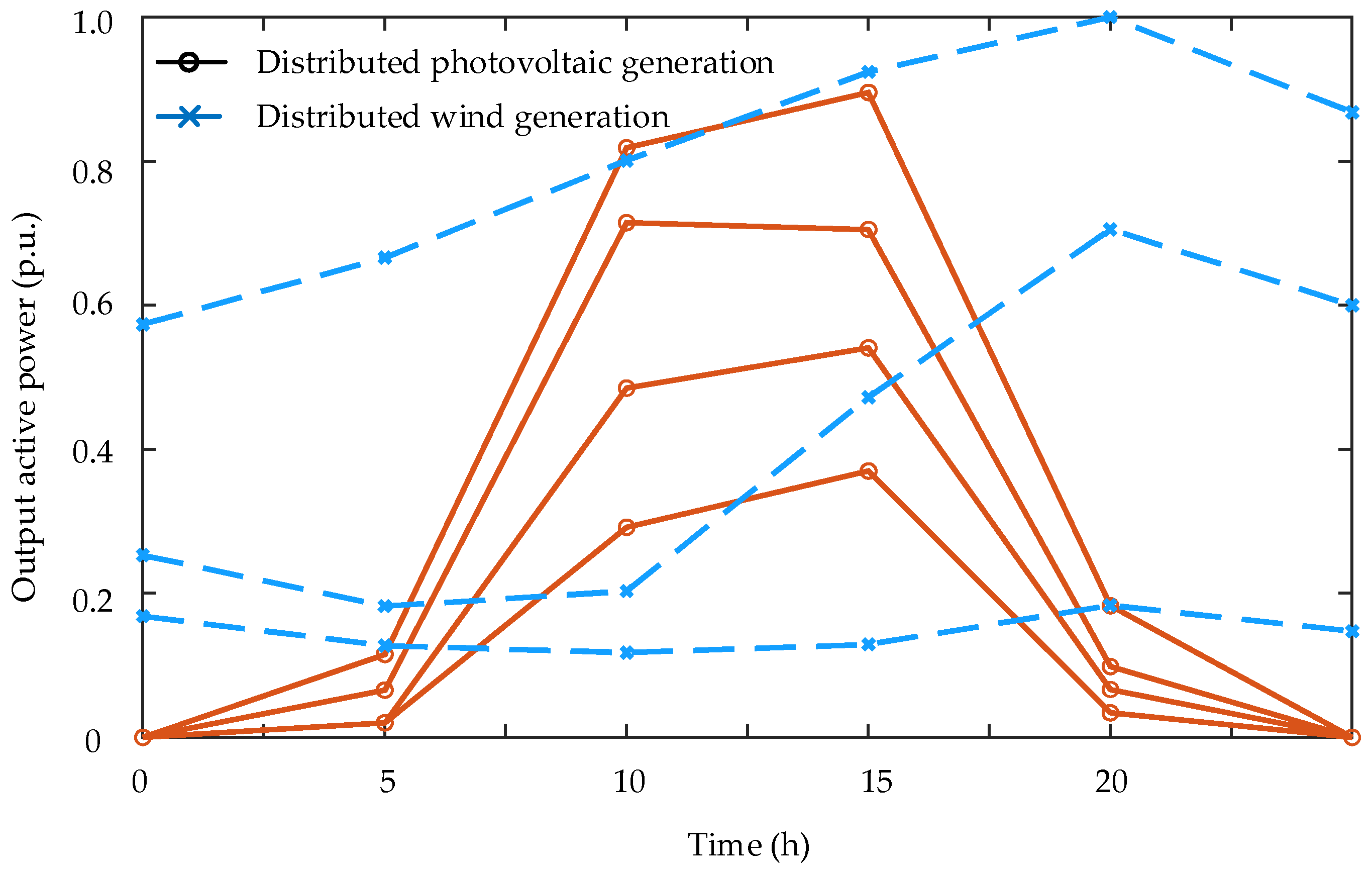
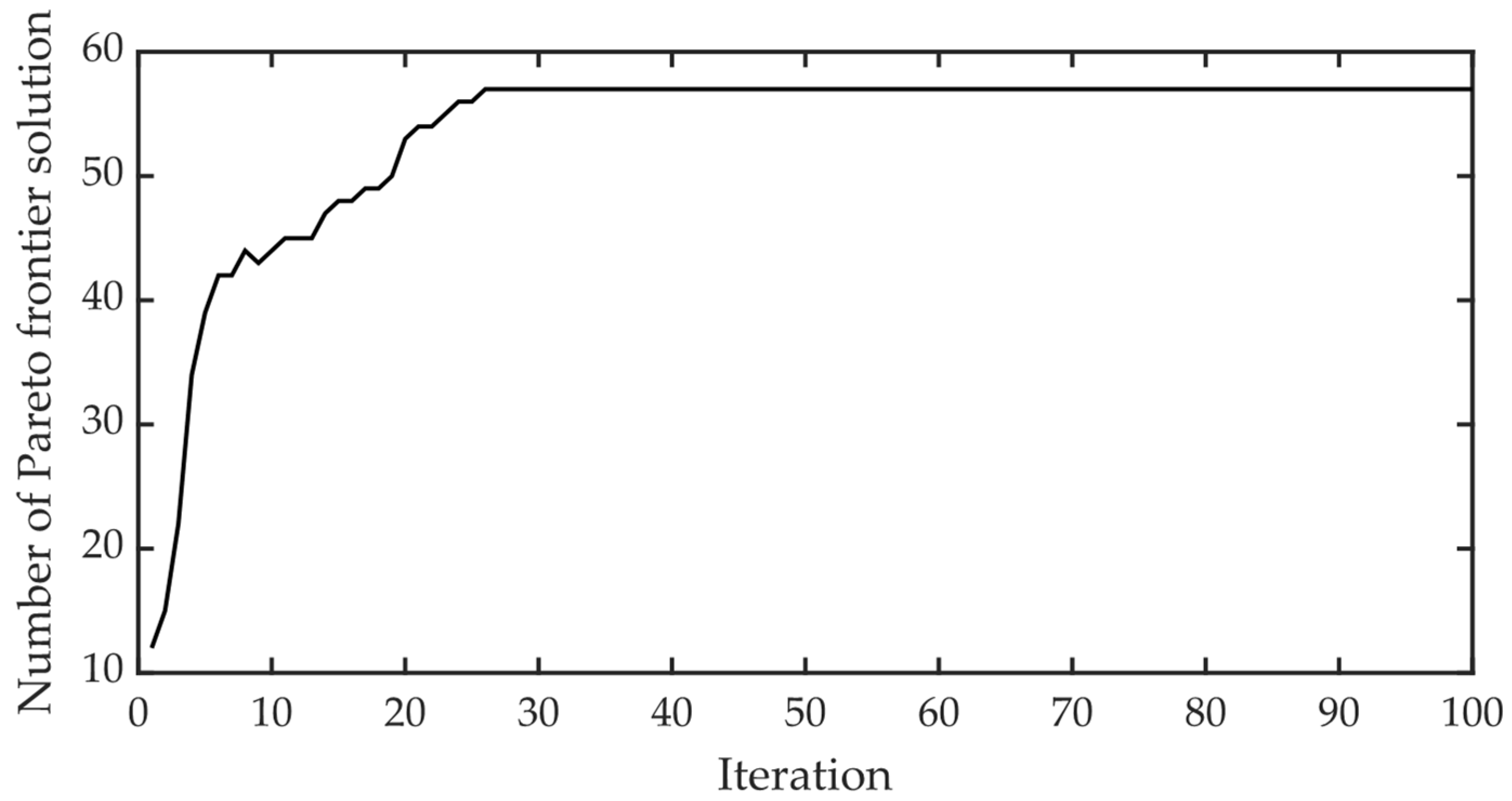
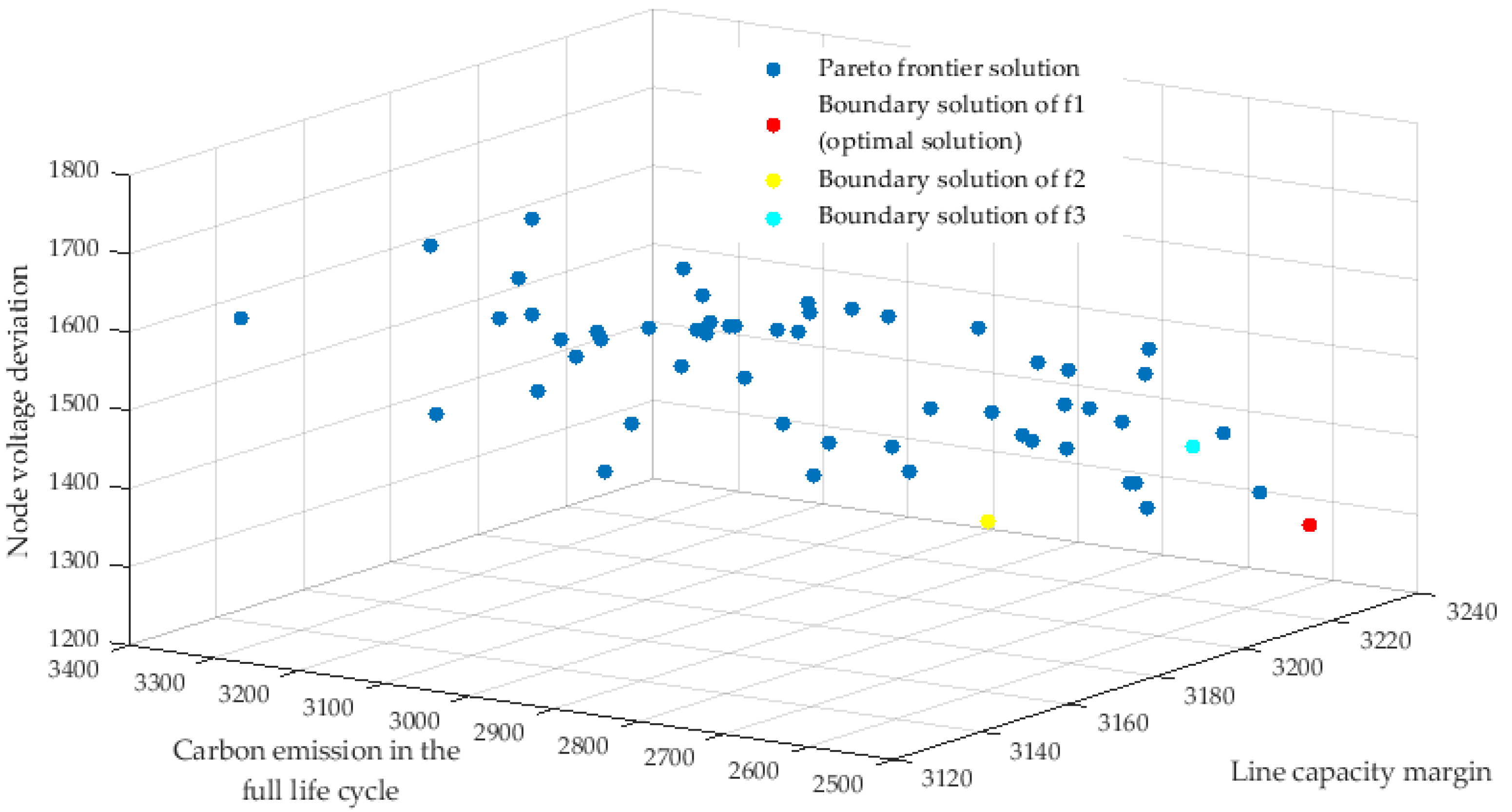

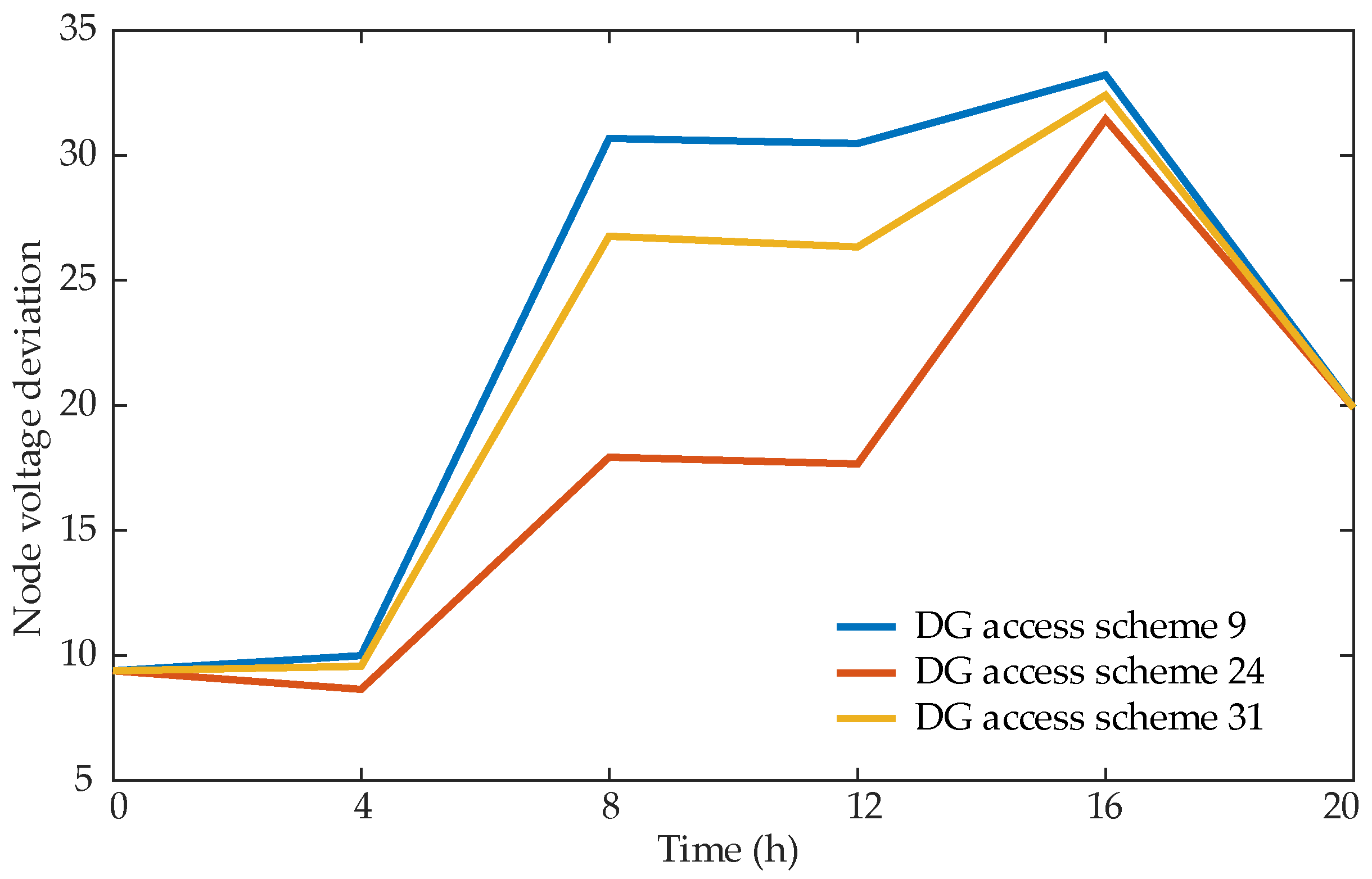
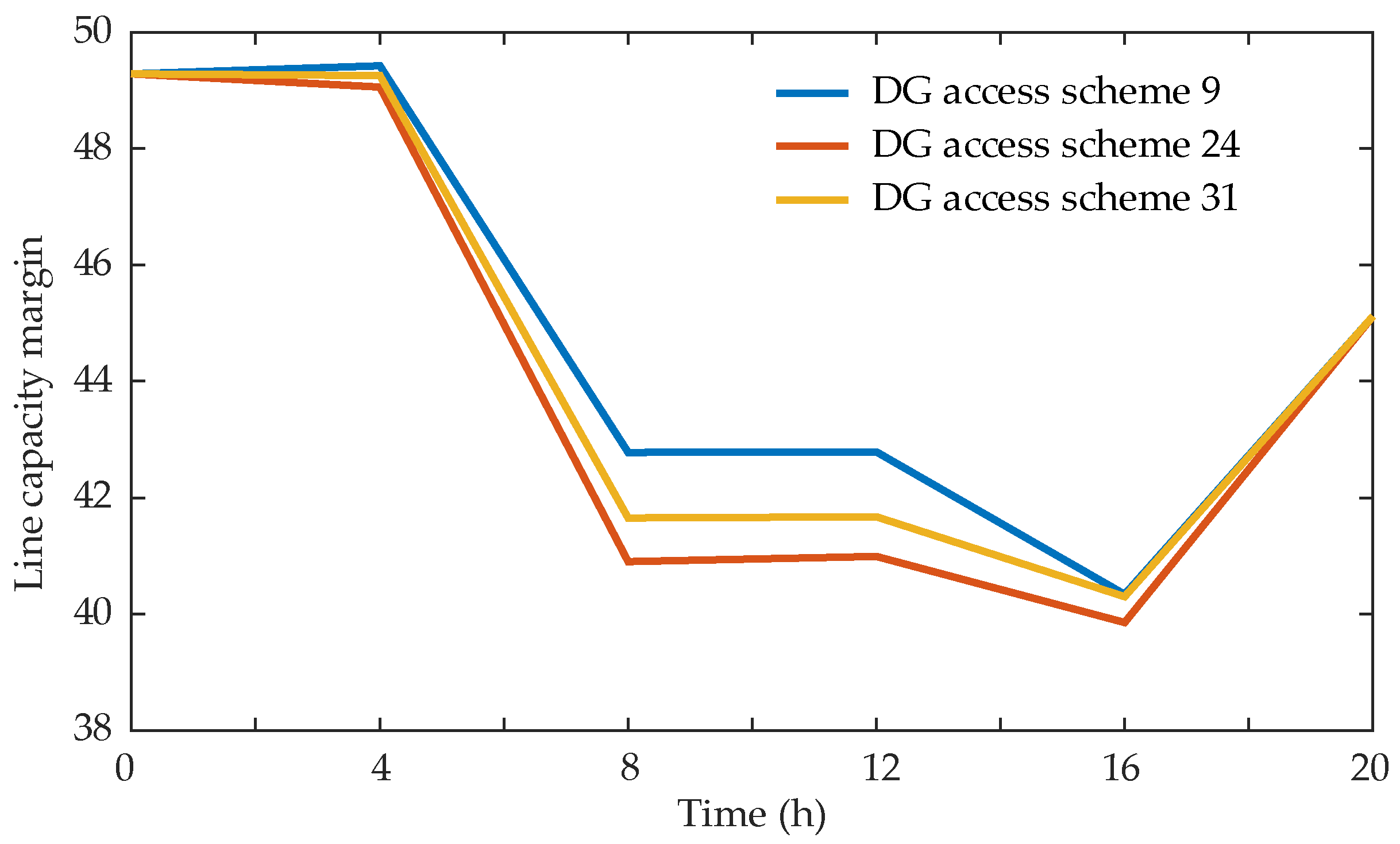

| Number of Node | Capacity of DG (MW) | Number of Node | Capacity of DG (MW) |
|---|---|---|---|
| 3 | 3.4 | 36 | 6.3 |
| 5 | 3.5 | 37 | 7.7 |
| 6 | 5.2 | 39 | 1.6 |
| 7 | 7.2 | 40 | 9.7 |
| 9 | 8.3 | 41 | 9.5 |
| 11 | 8.5 | 50 | 5.2 |
| 12 | 7.7 | 51 | 8.0 |
| 29 | 6.5 | 54 | 0.9 |
| 30 | 1.3 | 55 | 3.8 |
| 34 | 0.6 |
| Case | Algorithm | Minimum Carbon Emission of the Full Life Cycle (f1) | Minimum Node Voltage Deviation (f2) | Maximum Line Capacity Margin (f3) |
|---|---|---|---|---|
| 1 | Improved NSGA-II | 2536.58 | 1251.98 | 3224.30 |
| 2 | NSGA-II | 2609.22 | 1313.36 | 3222.40 |
Publisher’s Note: MDPI stays neutral with regard to jurisdictional claims in published maps and institutional affiliations. |
© 2022 by the authors. Licensee MDPI, Basel, Switzerland. This article is an open access article distributed under the terms and conditions of the Creative Commons Attribution (CC BY) license (https://creativecommons.org/licenses/by/4.0/).
Share and Cite
Huang, Y.; Zhao, L.; Qiu, W.; Xu, Y.; Gao, J.; Yan, Y.; Wu, T.; Lin, Z. Evaluation of Acceptance Capacity of Distributed Generation in Distribution Network Considering Carbon Emission. Energies 2022, 15, 4406. https://doi.org/10.3390/en15124406
Huang Y, Zhao L, Qiu W, Xu Y, Gao J, Yan Y, Wu T, Lin Z. Evaluation of Acceptance Capacity of Distributed Generation in Distribution Network Considering Carbon Emission. Energies. 2022; 15(12):4406. https://doi.org/10.3390/en15124406
Chicago/Turabian StyleHuang, Yixin, Lei Zhao, Weiqiang Qiu, Yuhang Xu, Junyan Gao, Youxiang Yan, Tong Wu, and Zhenzhi Lin. 2022. "Evaluation of Acceptance Capacity of Distributed Generation in Distribution Network Considering Carbon Emission" Energies 15, no. 12: 4406. https://doi.org/10.3390/en15124406
APA StyleHuang, Y., Zhao, L., Qiu, W., Xu, Y., Gao, J., Yan, Y., Wu, T., & Lin, Z. (2022). Evaluation of Acceptance Capacity of Distributed Generation in Distribution Network Considering Carbon Emission. Energies, 15(12), 4406. https://doi.org/10.3390/en15124406






